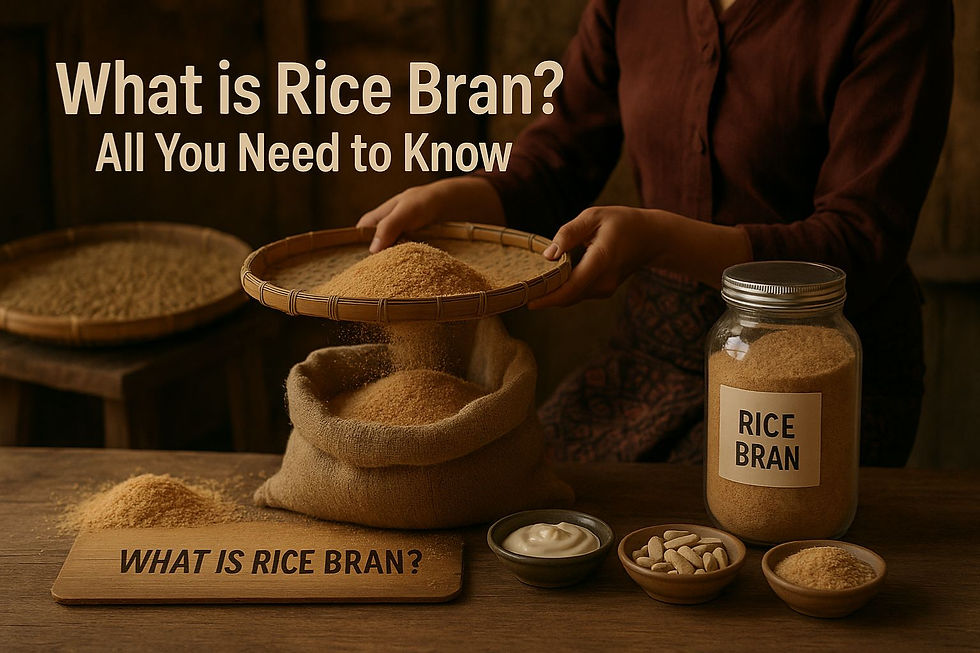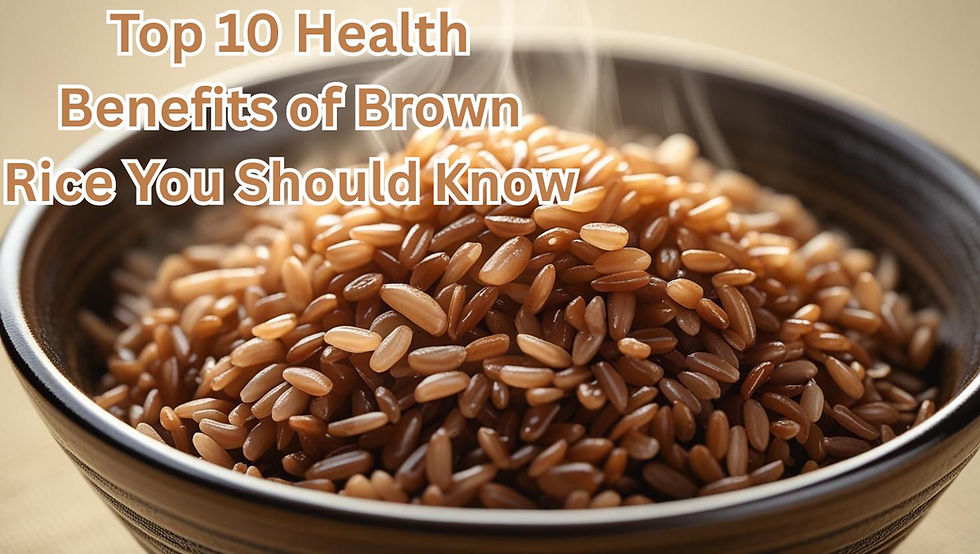What is Rice Bran? All You Need to Know
- Rajan Magar
- Jun 24
- 5 min read

When we refer to rice, everyone imagines the white or brown rice grains on the plate. Yet, have you ever stopped to consider what becomes of rice grains' outer layers when they are processed? That outer layer goes by the name rice bran, and it is one of the most underappreciated nutritional giants in the rice universe.
Rice bran is the hard outer shell of the rice grain that's discarded in milling when white rice is manufactured. It contains the pericarp, seed coat, nucellus, and aleurone layers. While it's relegated during milling, rice bran is highly nutritious, antioxidant, and healthy fat-rich, rendering it a noteworthy co-product of rice processing.
Let's dive into all about rice bran from how it's created to its unexpected health advantages and its connection to different types of rice.
How is Rice Bran Made?
In order to learn about processed rice bran, first we must learn about the processing of rice. Rice, once it is harvested, retains a few layers. The very outermost layer is the husk, which is stripped off first to create brown rice. Brown rice retains the bran layer. When this bran is stripped away normally while polishing to yield white rice rice bran is harvested.
It's primarily manufactured in the processing of Non Basmati Rice and Basmati Rice, and utilized for oil extraction, animal feed, and even dietary supplements.
Nutritional Composition of Rice Bran
Rice bran is rich in nutrients that can contribute to health in several ways. Some of its important constituents include:
Dietary fiber – supports digestive well-being
Healthy fats – such as omega-3 and omega-6 fatty acids
Vitamin E – particularly tocopherols and tocotrienols
Minerals – such as magnesium, potassium, and iron
Antioxidants – like ferulic acid, which combat free radicals
Due to this impressive nutritional composition, rice bran is regarded as a functional food in most nations.
Health Benefits of Rice Bran
1. Enhances Heart Health
Rice bran has excessive levels of dietary fiber and plant sterols, which reduce LDL cholesterol levels. That makes it heart-friendly and can lower the risk of cardiovascular diseases.
2. Maintains Digestive Health
Due to its fiber, rice bran facilitates digestion through the provision of regular bowel movements and the prevention of constipation. It also maintains the health of good gut bacteria.
3. Enhances Immunity
The antioxidants present in rice bran — particularly vitamin E compounds and ferulic acid — enhance the immune system and guard the body against oxidative stress.
4. Maintains Blood Sugar Levels
A number of studies indicate that rice bran is able to moderate blood sugar rises, so it is useful for those who suffer from diabetes or have an at-risk factor for developing diabetes.
5. Facilitates Weight Control
The healthy fats and fiber in rice bran are responsible for filling you up for longer and cutting down on unwanted munching.
How Rice Bran is Used
Rice bran is more than a by-product; it has many uses:
1. Rice Bran Oil
It is the most popular commercial application. Rice bran oil has a high smoke point and a delicate taste, which makes it ideal for frying. It's also vouched for by experts for its cardiovascular benefits.
2. Animal Feed
Rice bran is used extensively in cattle and chicken feed due to its high nutrient value, particularly in rice-growing nations such as India.
3. Cosmetic and Skincare Products
The natural oils and antioxidants in rice bran are great for the skin. It's therefore a component in some sunscreens, lotions, and soaps.
4. Dietary Supplements
Rice bran is converted into capsules or powders for individuals who want to increase their antioxidant and fiber intake.
Rice Bran and Different Types of Rice
India, a prominent Non Basmati Rice exporter of India, grows rice in several forms. Knowledge of these varieties can help you better understand the sources of rice bran.
1. Basmati Rice
This long-grain fragrance rice is renowned for its unique flavor and airy texture. When processed, the bran covering is eliminated to provide us with white basmati rice.
In return, basmati rice bran.
2. Red Rice
Red rice keeps its bran layer, which makes it reddish in color and nutty in taste. Because the bran is not stripped, red rice is more fiber and nutrient-rich than white rice by nature.
Parboiling is a treatment whereby rice is half-boiled in the husk. This treatment forces some of the nutrients from the bran into the grain, which is more nutritious than plain white rice. Although the outer bran is still eliminated, the advantages linger in the grain to some degree.
4. Sticky Rice
Also referred to as glutinous rice, sticky rice has a distinctive texture and is widely applied in Southeast Asian cooking. Sticky rice comes with a bran layer when it's not polished, though it's commonly eaten without it.
Leftover rice can be reused in many different ways, ranging from fried rice to rice snacks. It should be mentioned that although rice bran is eliminated in polished rice, whole-grain rice or unpolished rice-based dishes still contain some of the benefits.
The Role of India in Rice Bran Production
India is a top producer and exporter of rice, both Basmati and Non Basmati rice. Consequently, India is also a significant global rice bran producer. Rice mills all over India use bran extraction technology to utilize this precious by-product to the fullest.
Large rice-growing states such as Punjab, Haryana, Chhattisgarh, Andhra Pradesh, and West Bengal produce humongous amounts of rice bran annually. As awareness of the advantages of rice bran increases, there is now a growing demand in the international market — not only for rice, but also for value-added commodities such as rice bran oil.
Why You Should Care About Rice Bran?
You may not see rice bran on your dinner plate, but that does not mean that it doesn't belong to your food chain. Whether it is in your cooking oil, your face cream, or your dietary supplements — rice bran has a part to play in your daily life.
Including whole-grain rice types like red rice, brown rice, or even parboiled rice can indirectly benefit you from nutrients present in rice bran. In addition, promoting sustainable rice practices and exploring various types of rice enable you to make smart decisions that are beneficial to your health as well as the environment.
Final Thoughts
Rice bran is more than a milling by-product — it's a high-nutrient ingredient with far-reaching health implications. Whether you're investigating the range of Indian rice varieties such as Basmati Rice, Red Rice, or Parboiled Rice, or simply wondering what happens to your rice before it lands on your plate, knowledge of rice bran gives a whole new depth to the discussion.
For industry players, particularly in rice-exporting countries such as India, rice bran is an untapped gem waiting to be discovered. And for consumers, it's yet another reason to love rice in all its configurations.



Comments